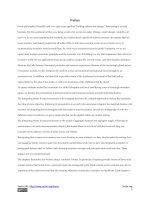Principles of macroeconomics 10e by case fair oster ch15
Bạn đang xem bản rút gọn của tài liệu. Xem và tải ngay bản đầy đủ của tài liệu tại đây (1.1 MB, 38 trang )
PRINCIPLES OF
MACROECONOMICS
PART IV Further Macroeconomics Issues
TENTH
EDITION
CASE FAIR OSTER
© 2012 Pearson Education, Inc. Publishing as Prentice Hall
Prepared by: Fernando Quijano & Shelly
1 ofTefft
24
PART IV Further Macroeconomics Issues
© 2012 Pearson Education, Inc. Publishing as Prentice Hall
2 of 38
PART IV FURTHER MACROECONOMICS ISSUES
Financial
Crises,
Stabilization,
and Deficits
15
CHAPTER OUTLINE
The Stock Market, the Housing Market, and
Financial Crises
PART IV Further Macroeconomics Issues
Stocks and Bonds
Determining the Price of a Stock
The Stock Market Since 1948
Housing Prices Since 1952
Household Wealth Effects on the Economy
Financial Crises and the 2008 Bailout
Asset Markets and Policy Makers
© 2012 Pearson Education, Inc. Publishing as Prentice Hall
Time Lags Regarding Monetary and Fiscal
Policy
Stabilization
Recognition Lags
Implementation Lags
Response Lags
Summary
Government Deficit Issues
Deficit Targeting
3 of 38
The Stock Market, the Housing Market, and Financial Crises
Stocks and Bonds
stock A certificate that certifies ownership of a certain
portion of a firm.
capital gain An increase in the value of an asset.
PART IV Further Macroeconomics Issues
realized capital gain The gain that occurs when the owner
of an asset actually sells it for more than he or she paid for it.
© 2012 Pearson Education, Inc. Publishing as Prentice Hall
4 of 38
The Stock Market, the Housing Market, and Financial Crises
Determining the Price of a Stock
Stock prices are affected by people’s expectations of future dividends.
The larger the expected future dividends, the larger the current stock
price, other things being equal.
PART IV Further Macroeconomics Issues
The farther into the future the dividend is expected to be paid, the
more it will be “discounted.” The amount discounted depends on the
interest rate. The larger the interest rate, the more expected future
dividends will be discounted.
The discount for risk must also be taken into account.
The price of a stock should equal the discounted value of its expected
future dividends, where the discount factors depend on the interest
rate and risk.
Stock prices may also depend on what people expect others will pay
for the stock in the future, bringing about stock market “bubbles.”
© 2012 Pearson Education, Inc. Publishing as Prentice Hall
5 of 38
The Stock Market, the Housing Market, and Financial Crises
The Stock Market Since 1948
Dow Jones Industrial Average An index based on the stock
prices of 30 actively traded large companies. The oldest and
most widely followed index of stock market performance.
PART IV Further Macroeconomics Issues
NASDAQ Composite An index based on the stock prices of
over 5,000 companies traded on the NASDAQ Stock Market.
The NASDAQ market takes its name from the National
Association of Securities Dealers Automated Quotation System.
Standard and Poor’s 500 (S&P 500) An index based on the
stock prices of 500 of the largest firms by market value.
© 2012 Pearson Education, Inc. Publishing as Prentice Hall
6 of 38
The Stock Market, the Housing Market, and Financial Crises
PART IV Further Macroeconomics Issues
The Stock Market Since 1948
FIGURE 15.1 The S&P 500 Stock Price Index, 1948 I–2010 I
© 2012 Pearson Education, Inc. Publishing as Prentice Hall
7 of 38
The Stock Market, the Housing Market, and Financial Crises
PART IV Further Macroeconomics Issues
The Stock Market Since 1948
FIGURE 15.2 Ratio of After-Tax Profits to GDP, 1948 I–2010 I
© 2012 Pearson Education, Inc. Publishing as Prentice Hall
8 of 38
E C O N O M I C S I N PRACTI C E
Bubbles or Rational Investors?
PART IV Further Macroeconomics Issues
The huge increase in U.S. stock prices in
the last half of the 1990s is a puzzle. So
also is the huge increase in U.S. housing
prices between 2002 and 2006. Many
other countries have seen large increases
in asset prices since then as well.
An interesting question is whether these
rapid run-ups in prices are bubbles,
generated by irrational consumers and
investors, or are instead the result of
actions of rational investors that simply turned out with hindsight to be wrong.
A key policy question is whether the Fed should ignore asset prices or try to use
interest rates to control them.
Bernanke’s Bubble Laboratory: Princeton Protégés
of Fed Chief Study the Economics of Manias
The Wall Street Journal
© 2012 Pearson Education, Inc. Publishing as Prentice Hall
9 of 38
The Stock Market, the Housing Market, and Financial Crises
PART IV Further Macroeconomics Issues
Housing Prices Since 1952
FIGURE 15.3 Ratio of a Housing Price Index to the GDP Deflator, 1952 I–2010 I
© 2012 Pearson Education, Inc. Publishing as Prentice Hall
10 of 38
The Stock Market, the Housing Market, and Financial Crises
Household Wealth Effects on the Economy
An increase in wealth increases consumer spending. Fluctuations in
household wealth are due to fluctuations in stock prices and housing
prices. With unpredictable wealth change, we end up with unpredictable
consumption changes and thus unpredictable changes in GDP.
PART IV Further Macroeconomics Issues
Financial Crises and the 2008 Bailout
In a financial crisis, macroeconomic problems caused by the wealth
effect of a falling stock market or housing market are accentuated.
Many people consider the large fall in housing prices that began at the
end of 2006 to have led to the financial crisis of 2008–2009.
Many large financial institutions were involved in the mortgage market,
most of which were bailed out by the federal government—a $700
billion bailout bill that was passed in October 2008. This lessened the
negative wealth effect but had bad income distribution consequences.
© 2012 Pearson Education, Inc. Publishing as Prentice Hall
11 of 38
The Stock Market, the Housing Market, and Financial Crises
Asset Markets and Policy Makers
Policy makers’ ability to stabilize the economy is considerably
restricted by the fact that changes in asset prices affect the economy
and are not predictable.
PART IV Further Macroeconomics Issues
Perhaps the U.S. government (including the Fed) should have seen in
the 2002–2005 period the excessive risk that was being taken and
instituted added government regulation.
© 2012 Pearson Education, Inc. Publishing as Prentice Hall
12 of 38
E C O N O M I C S I N PRACTI C E
Financial Reform Bill
PART IV Further Macroeconomics Issues
In July 2010 in the aftermath of the financial crisis and subsequent bailout of
much of the U.S. banking system, as a response to pressure for increased
regulation of the banking system, Congress passed the Dodd-Frank Wall Street
Reform and Consumer Protection Act.
Congress Passes Financial Reform Bill
The Washington Post
© 2012 Pearson Education, Inc. Publishing as Prentice Hall
13 of 38
Time Lags Regarding Monetary and Fiscal Policy
FIGURE 15.4 Two Possible Time Paths for GDP
PART IV Further Macroeconomics Issues
Path A is less stable—it varies more over time—than path
B.
Other things being equal, society prefers path B to path A.
stabilization policy Describes both monetary and fiscal policy, the
goals of which are to smooth out fluctuations in output and
employment and to keep prices as stable as possible.
time lags Delays in the economy’s response to stabilization policies.
© 2012 Pearson Education, Inc. Publishing as Prentice Hall
14 of 38
PART IV Further Macroeconomics Issues
The main goal of stabilization policy is to:
a.
Take economic measures that enhance the credibility of
government institutions.
b.
Be prepared to handle destabilizing economic situations, such as a
bank run.
c.
Use monetary and fiscal policy to smooth out fluctuations in
output, employment, and prices.
d.
Use economic policy to solve social problems such as crime or
child neglect.
© 2012 Pearson Education, Inc. Publishing as Prentice Hall
15 of 38
PART IV Further Macroeconomics Issues
The main goal of stabilization policy is to:
a.
Take economic measures that enhance the credibility of
government institutions.
b.
Be prepared to handle destabilizing economic situations, such as a
bank run.
c.
Use monetary and fiscal policy to smooth out fluctuations in
output, employment, and prices.
d.
Use economic policy to solve social problems such as crime or
child neglect.
© 2012 Pearson Education, Inc. Publishing as Prentice Hall
16 of 38
Time Lags Regarding Monetary and Fiscal Policy
FIGURE 15.5 Possible Stabilization Timing Problems
Stabilization
Attempts to stabilize the economy can prove destabilizing because of time lags.
An expansionary policy that should have begun to take effect at point A does not actually
begin to have an impact until point D, when the economy is already on an upswing.
Hence, the policy pushes the economy to points E′ and F′ (instead of points E and F).
PART IV Further Macroeconomics Issues
Income varies more widely than it would have if no policy had been implemented.
© 2012 Pearson Education, Inc. Publishing as Prentice Hall
17 of 38
PART IV Further Macroeconomics Issues
A leading critic of stabilization policy that likened government attempts
to stabilize the economy to a “fool in the shower” is:
a.
John Maynard Keynes.
b.
Adam Smith.
c.
Milton Friedman.
d.
Jean-Paul Sartre.
© 2012 Pearson Education, Inc. Publishing as Prentice Hall
18 of 38
PART IV Further Macroeconomics Issues
A leading critic of stabilization policy that likened government attempts
to stabilize the economy to a “fool in the shower” is:
a.
John Maynard Keynes.
b.
Adam Smith.
c.
Milton Friedman.
d.
Jean-Paul Sartre.
© 2012 Pearson Education, Inc. Publishing as Prentice Hall
19 of 38
Time Lags Regarding Monetary and Fiscal Policy
Recognition Lags
recognition lag The time it takes for policy makers to
recognize the existence of a boom or a slump.
Implementation Lags
PART IV Further Macroeconomics Issues
implementation lag The time it takes to put the desired policy
into effect once economists and policy makers recognize that
the economy is in a boom or a slump.
Response Lags
response lag The time that it takes for the economy to adjust
to the new conditions after a new policy is implemented; the
lag that occurs because of the operation of the economy itself.
© 2012 Pearson Education, Inc. Publishing as Prentice Hall
20 of 38
PART IV Further Macroeconomics Issues
Which lag occurs because of the operation of the economy, or the time
it takes for the multiplier to reach its full value?
a.
The recognition lag.
b.
The implementation lag.
c.
The response lag.
d.
All of the above refer to how the economy adjusts after a new
policy is implemented.
© 2012 Pearson Education, Inc. Publishing as Prentice Hall
21 of 38
PART IV Further Macroeconomics Issues
Which lag occurs because of the operation of the economy, or the time
it takes for the multiplier to reach its full value?
a.
The recognition lag.
b.
The implementation lag.
c.
The response lag.
d.
All of the above refer to how the economy adjusts after a new
policy is implemented.
© 2012 Pearson Education, Inc. Publishing as Prentice Hall
22 of 38
Time Lags Regarding Monetary and Fiscal Policy
Response Lags
Response Lags for Fiscal Policy
There is a lag between the time a fiscal policy action is initiated
and the time the full change in GDP is realized.
PART IV Further Macroeconomics Issues
Until individuals or firms can revise their spending plans, extra
government spending does not stimulate extra private spending.
Response Lags for Monetary Policy
Monetary policy works by changing interest rates, which then
change planned investment.
The response of consumption and investment to interest rate
changes takes time.
© 2012 Pearson Education, Inc. Publishing as Prentice Hall
23 of 38
Time Lags Regarding Monetary and Fiscal Policy
Summary
Stabilization is not easily achieved even if there are no surprise assetprice changes.
PART IV Further Macroeconomics Issues
It takes time for policy makers to recognize the existence of a problem,
more time for them to implement a solution, and yet more time for
firms and households to respond to the stabilization policies taken.
Monetary policy can be adjusted more quickly and easily than taxes or
government spending, making it a useful instrument in stabilizing the
economy.
But because the economy’s response to monetary changes is
probably slower than its response to changes in fiscal policy, tax and
spending changes may also play a useful role in macroeconomic
management.
© 2012 Pearson Education, Inc. Publishing as Prentice Hall
24 of 38
PART IV Further Macroeconomics Issues
Which of the following changes in fiscal policy has a shorter response
lag than the others?
a.
An increase in government spending.
b.
A cut in personal taxes.
c.
A cut in business taxes.
d.
All of the above measures have about the same response lag.
© 2012 Pearson Education, Inc. Publishing as Prentice Hall
25 of 38









